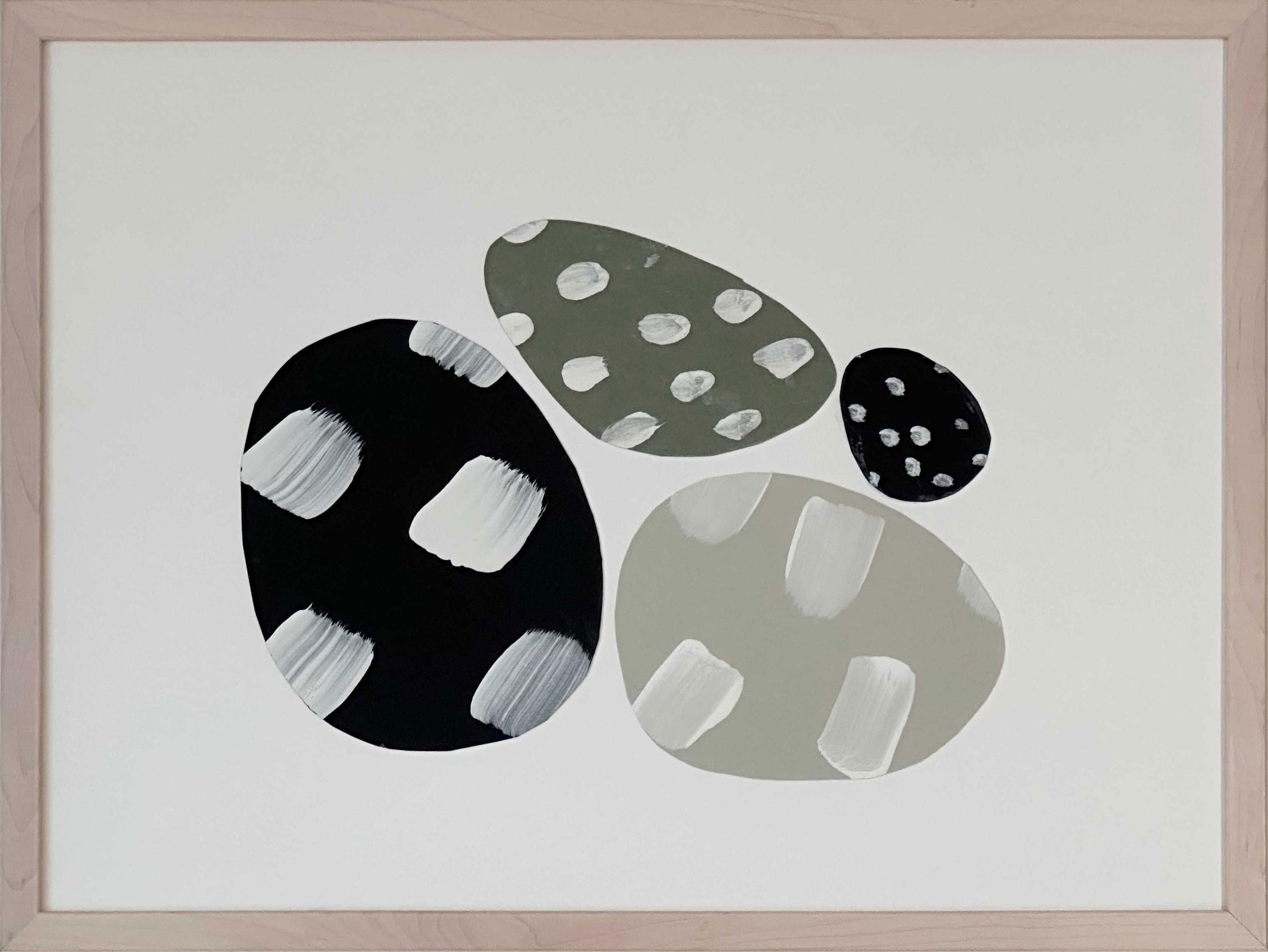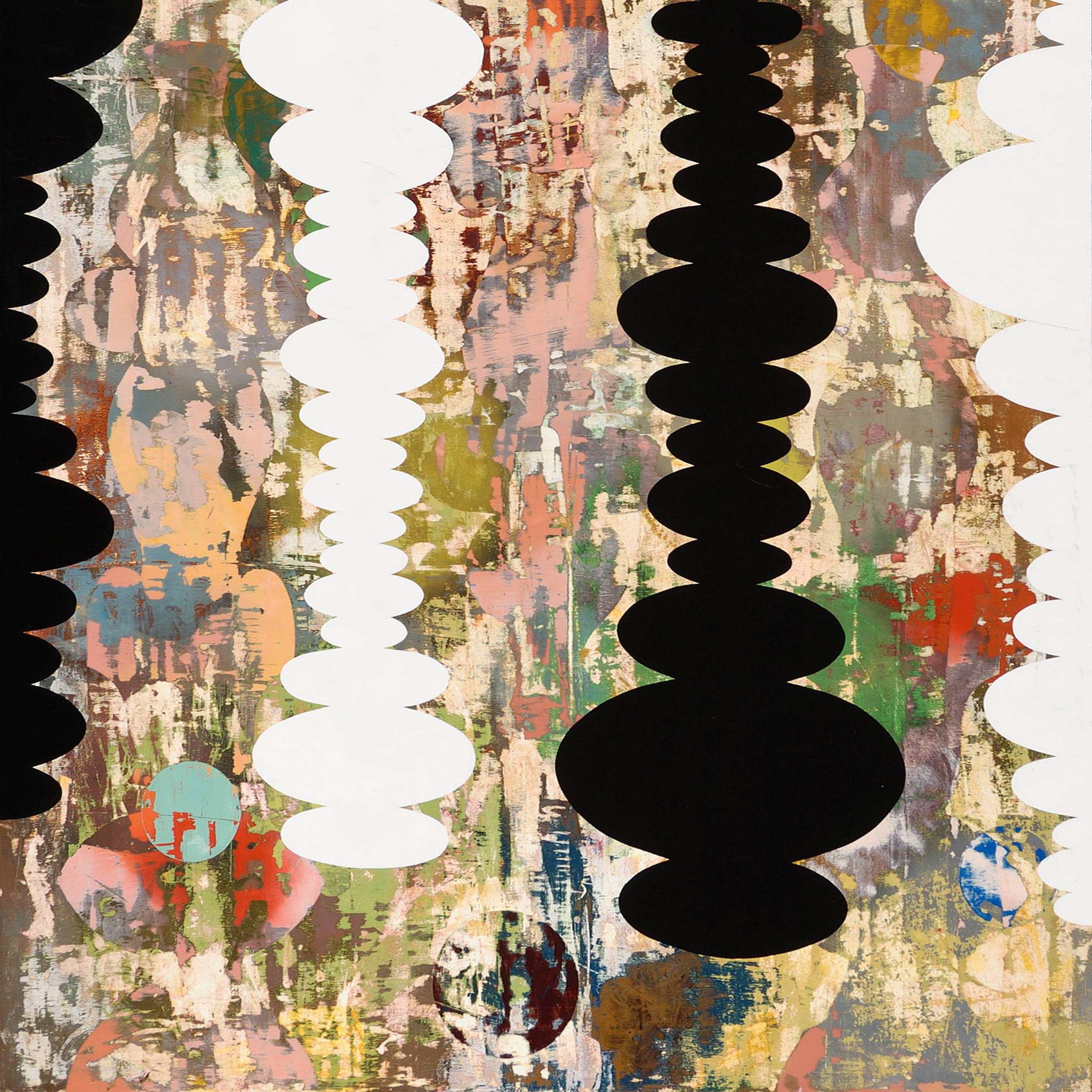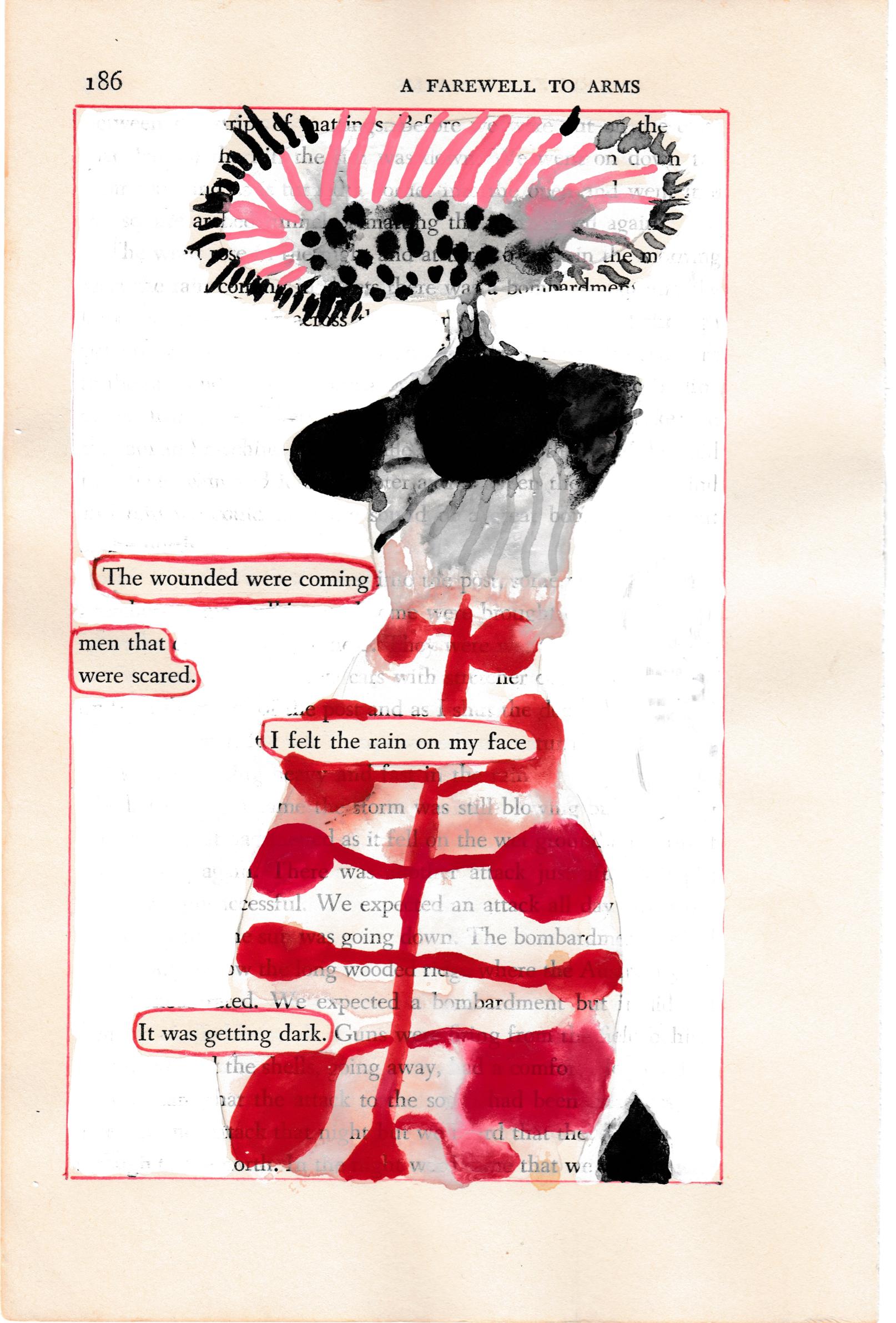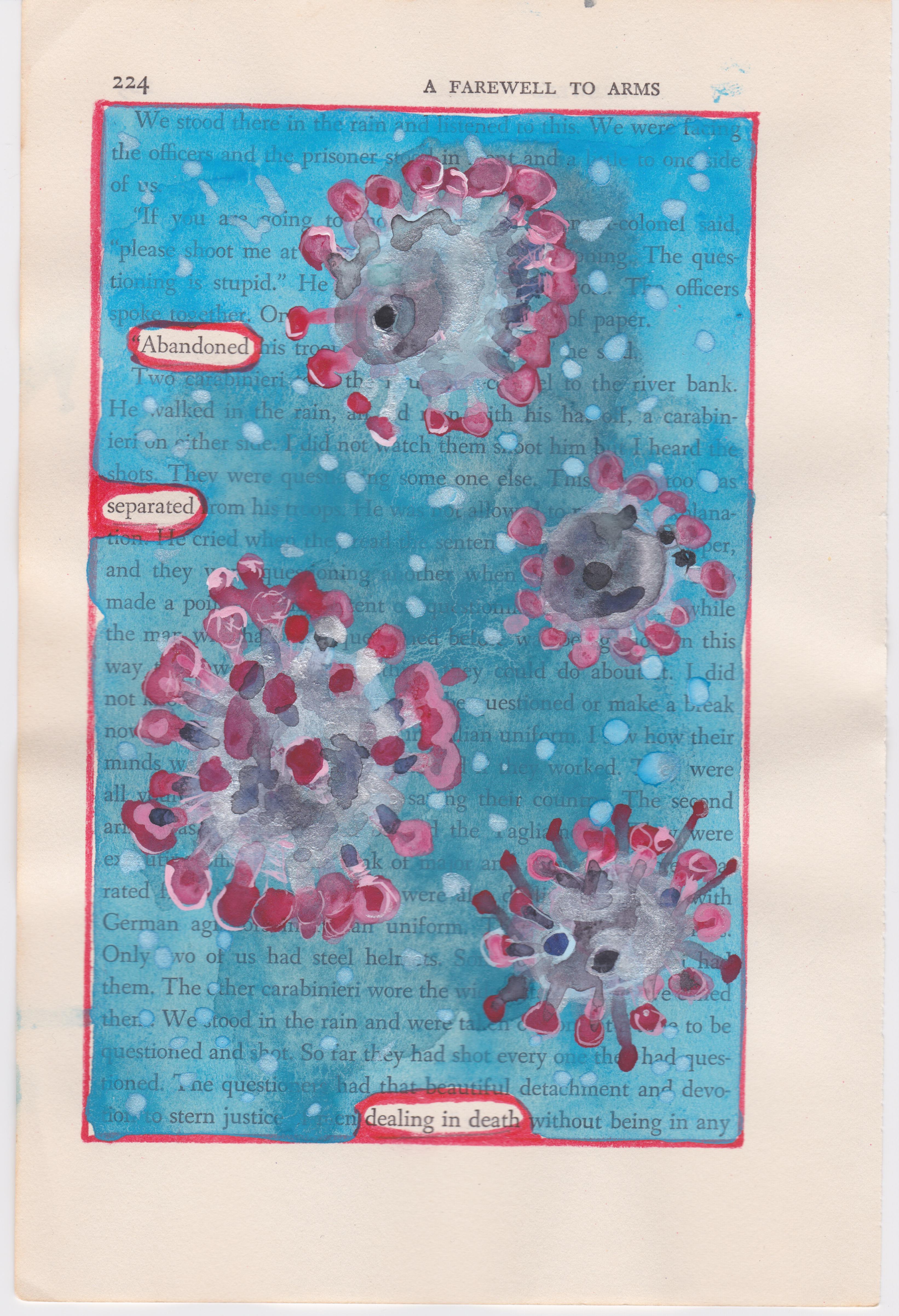Items Similar to ABSTRACT American Woman Abstract Non-objective Mid 20th Century Modern Drawing
Want more images or videos?
Request additional images or videos from the seller
1 of 7
Irene Rice PereiraABSTRACT American Woman Abstract Non-objective Mid 20th Century Modern Drawingc. 1950s
c. 1950s
About the Item
ABSTRACT American Woman Abstract Non-objective Mid 20th Century Modern Drawing
Irene Rice Pereira (1902-1971)
Abstract
12 x 6 1/2 inches
Watercolor, gouache, and ink on black paper
Signed lower right
BIO
Born Irene Rice, she took the name of her first husband, the commercial artist Umberto Pereira. She adopted the name I. Rice Pereira because then as now discrimination beset women in the arts. By the time war broke out Irene had divorced Pereira and married George Wellington Brown, a marine engineer from a prominent Boston family. Brown was an ingenious experimenter with materials, and he encouraged his petite new wife in their mutual passion for experimentation. Pereira in the 1930s was drawn to ships, not only because of George Brown, but because of their intricate machinery, their functional beauty. The inside-out infrastructure of the Pompidou museum in Paris amused Pereira, although she thought it art-historically tardy.
Irene Rice Pereira was a lovely, fragile being. Her presence was hushed. She spoke almost in a whisper and listened far more than she spoke. She was a prodigious autodidact and a spellbinding lecturer. The main body of her metaphysical library today resides in the Museum for Women in the Arts in Washington, D.C. Her papers and the manuscript for her still unpublished book, Eastward Journey, are available to scholars in the Schlesinger Library at Harvard.
Pereira won recognition for her abstract geometric work, particularly her jewel-like works on fluted and coruscated layers of glass, throughout the 1940s and early 1950s. In 1953 the Whitney Museum, then in Greenwich Village, gave her a retrospective exhibition with Loren MacIver, and that same year Life magazine published a centerfold photo examination of her work.
By the late 1950s Abstract Expressionism had swept Manhattan, flattening such nascent movements as Geometric Abstraction. Such artists as Stuart Davis, Stanton MacDonald Wright, George L.K. Morris, George Ault, Jan Matulka, Richard Leahy, Philip Guston and many others were eclipsed. Pereira believed that a European angst, brought to our shores in the wake of the Holocaust, had introduced a cynicism and a profoundly anti-female sensibility that boded ill for art in America. Rightly she pointed out that even when the works of women were acquired by museums they were rarely shown, a disgrace that persists to this day. The women who did achieve success, she said, were often collaborators with more famous male artists and tastemakers.
Pereira died in 1971 in Marbella, Spain, ill and broken-hearted. She had been evicted from the Fifteenth Street studio in Chelsea where she had painted for more than thirty years. Suffering from severe emphysema, she could barely negotiate a few stairs.
But by the 1980s a new generation of women scholars and curators had begun to resurrect her stature. A considerable following has formed to honor a pioneer artist who cared about other artists and willingly paid the price to denounce what others feared in silence. Indeed when Pereira sold a painting she had two immediate impulses: buy a new hat, and give the money to an artist friend in trouble. She loved hats but loved to help fellow artists even more.
- Creator:Irene Rice Pereira (1902-1971, American)
- Creation Year:c. 1950s
- Dimensions:Height: 18 in (45.72 cm)Width: 12 in (30.48 cm)
- Medium:
- Movement & Style:
- Period:
- Condition:
- Gallery Location:New York, NY
- Reference Number:1stDibs: LU1156214153162
Irene Rice Pereira
Born Irene Rice, she took the name of her first husband, the commercial artist Umberto Pereira. She adopted the name I. Rice Pereira because then as now discrimination beset women in the arts. By the time war broke out Irene had divorced Pereira and married George Wellington Brown, a marine engineer from a prominent Boston family. Brown was an ingenious experimenter with materials, and he encouraged his petite new wife in their mutual passion for experimentation. Pereira in the 1930s was drawn to ships, not only because of George Brown, but because of their intricate machinery, their functional beauty. The inside-out infrastructure of the Pompidou museum in Paris amused Pereira, although she thought it art-historically tardy. Irene Rice Pereira was a lovely, fragile being. Her presence was hushed. She spoke almost in a whisper and listened far more than she spoke. She was a prodigious autodidact and a spellbinding lecturer. The main body of her metaphysical library today resides in the Museum for Women in the Arts in Washington, D.C. Her papers and the manuscript for her still unpublished book, Eastward Journey, are available to scholars in the Schlesinger Library at Harvard. Pereira won recognition for her abstract geometric work, particularly her jewel-like works on fluted and coruscated layers of glass, throughout the 1940s and early 1950s. In 1953 the Whitney Museum, then in Greenwich Village, gave her a retrospective exhibition with Loren MacIver, and that same year Life magazine published a centerfold photo examination of her work. By the late 1950s Abstract Expressionism had swept Manhattan, flattening such nascent movements as Geometric Abstraction. Such artists as Stuart Davis, Stanton MacDonald Wright, George L.K. Morris, George Ault, Jan Matulka, Richard Leahy, Philip Guston and many others were eclipsed. Pereira believed that a European angst, brought to our shores in the wake of the Holocaust, had introduced a cynicism and a profoundly anti-female sensibility that boded ill for art in America. Rightly she pointed out that even when the works of women were acquired by museums they were rarely shown, a disgrace that persists to this day. The women who did achieve success, she said, were often collaborators with more famous male artists and tastemakers. Pereira died in 1971 in Marbella, Spain, ill and broken-hearted. She had been evicted from the Fifteenth Street studio in Chelsea where she had painted for more than thirty years. Suffering from severe emphysema, she could barely negotiate a few stairs. But by the 1980s a new generation of women scholars and curators had begun to resurrect her stature. A considerable following has formed to honor a pioneer artist who cared about other artists and willingly paid the price to denounce what others feared in silence. Indeed when Pereira sold a painting she had two immediate impulses: buy a new hat, and give the money to an artist friend in trouble. She loved hats but loved to help fellow artists even more.
About the Seller
5.0
Platinum Seller
These expertly vetted sellers are 1stDibs' most experienced sellers and are rated highest by our customers.
Established in 2008
1stDibs seller since 2019
165 sales on 1stDibs
Typical response time: <1 hour
- ShippingRetrieving quote...Ships From: Pawling, NY
- Return PolicyA return for this item may be initiated within 3 days of delivery.
More From This SellerView All
- ABSTRACT American Woman Abstract Non-objective Mid 20th Century Modern DrawingBy Irene Rice PereiraLocated in New York, NYABSTRACT American Woman Abstract Non-objective Mid 20th Century Modern Drawing Irene Rice Pereira (1902-1971) Abstract 8 1/2 x 5 1/2 inches Watercolor, gouache, and ink on black pap...Category
1950s Abstract Abstract Drawings and Watercolors
MaterialsPaper, Watercolor, Gouache
- 1, 000 piece Museum Quality Collection of Art & Objects from NYC 1939 Worlds FairBy Ilya BolotowskyLocated in New York, NY1,000 piece Museum Quality Collection of Art & Objects from NYC 1939 Worlds Fair. Ilya Bolotowsky (1907-1981) "1939 World’s Fair Mural Study for the Hall of Medical Sciences...Category
1930s Abstract Geometric Abstract Drawings and Watercolors
MaterialsPaper, Gouache, Canvas, Plaster, Oil
- Abstract Cityscape Mid 20th Century Modern Cubist Work on Paper Drawing ArielBy Clarence Holbrook CarterLocated in New York, NYAbstract Cityscape Mid 20th Century Modern Cubist Work on Paper Drawing Ariel 11 x 4 1/2 inches. Framed by Heydenryk. Provenance: Gary Snyder Fine Art B...Category
1950s Abstract Abstract Drawings and Watercolors
MaterialsPaper, Gouache
- American Cubist Abstract Art Deco Avant-Garde Constructivism 20th Century ModernLocated in New York, NYAmerican Cubist Abstract Art Deco Avant-Garde Constructivism 20th Century Modern Florence Henri (American, 1893-1982) Composition 18 1/2 x 12 1/2 in...Category
1920s Abstract Abstract Paintings
MaterialsPaper, Gouache
- Italian Abstract Work on Paper Color Field Non-Objective European Mid-CenturyBy Piero DorazioLocated in New York, NYItalian Modern Abstract Work on Paper Color Field Non-Objective European Mid-Century - "Gonage" Dorazio completed "Gonage" in 1949 when just after the artist had been awarded a stipend by the French government and admission to the Academy Beaux Arts. There he met George Braque who became great friends but also an influence on Dorazio, of which "Gonage" is a living testament. "Gonage" actual size of the drawing measures 12 x 9 1/2 inches. It is signed on the lower right. The work is affixed to a 19 x 15 inch board which includes the artist's signature and date. There is a torn table on the lower left entitling the piece "Gonage". Provenance follows this piece as a gift in 1950 to the artist-colleague Luigi Lucioni, who then gifted it in 1955 to his friend, the uncle of the current owner who has owned the work since 1988. Bio Born in Italy, Piero Dorazio studied architecture in Rome. At the same time his first abstract works were executed. In 1947 he received a scholarship from the Ecole Nationale Supérieure des Beaux Arts in Paris, where he contacted Modern artists, who lived in Paris. He founded the galleries "Age d'Or" in Florence and Rome to represent avant-garde arts in Italy. During a one year stay in the USA he got acquainted with leading artists of Abstract Expressionism such as Marc Rothko...Category
1940s Abstract Abstract Drawings and Watercolors
MaterialsGouache, Board
- MODERNIST DRAWING New Hope Mid-Century WPA Abstract Non-Objective Jazz ModernBy Ramstonev (Ramsey/Stone/Evans co-operative)Located in New York, NYMODERNIST DRAWING New Hope Mid-Century WPA Abstract Non-Objective Jazz Modern. Signed with a "Ramstonev" stamp lower right. RAMSTONEV Cooperative Art Project (1937-1939). In the late 1930s, Charles Ramsey became close friends with Charles Evans and Louis Stone. He persuaded them to join him teaching his New Hope summer classes in non-objective painting. Soon, a history-making collaboration began. In 1937, meeting in Evans' studio at the rear of Cryer's Hardware store on Main Street in New Hope, a decision was made to establish the Co-Operative Painting Project. They were intrigued by the cooperative ad-lib process by which jazz musicians created their music. Believing this to be the quintessential American contribution to music, they theorized that a similar result might be obtainable with art, a "visual jam session." This particlarly fascinated Ramsey, who was a jazz buff and had a large collection of jazz records. The objective was to jointly collaborate in the creation of a painting as well as applying collective criticism during its creation. By creating forward movement by general consent, they believed they could produce a higher level of beauty. By consensus it was decided that subject matter would be non-objective. Up to eight people would participate and stop when the painting "felt" finished by common agreement. These co-operative works were done in several different mediums- the majority in pastel, but some in watercolor, gouache, graphite or cut paper collage. On occasion, the group would create a series, as opposed to a single work, created in steps by three or four artists. One of the occasional participants was famed New Hope poet, Stanley Kunitz. These series could range in number from four to sixteen paintings in each. The first of a series would be very basic and the last a fully finished work. In the scope of importance among the New Hope Modernist...Category
1930s American Modern Abstract Drawings and Watercolors
MaterialsPaper, Watercolor, Gouache
You May Also Like
- Collage on Paper sage green beige black abstract playful polka-dots organic ovalBy Amanda AndersenLocated in Hamburg, HH"Dotted Collection II" is a work on paper from a larger series of abstract collages by Amanda Andersen created in 2023. This series includes visual elements familiar to the artists ...Category
2010s Abstract Abstract Drawings and Watercolors
MaterialsPaper, Adhesive, Gouache, Archival Paper
- GoaBy Perry BurnsLocated in Fairfield, CTArtist's Statement: "My paintings are an attempt to synthesize and enlighten pursuits of eastern and western art and their traditions. Using the full visual language of abstraction –...Category
20th Century Abstract Abstract Drawings and Watercolors
MaterialsGouache, Monoprint, Paper, Watercolor
- "#186 – WOUNDED WERE COMING", ink, pencil, gouache, found vintage book, poetryBy Amy WilliamsLocated in Toronto, Ontario"#186 – WOUNDED WERE COMING" is from Amy Williams' series A Farewell to Arms – wherein the artist works directly onto pages of a found copy of Ernest Hemingway's WWII romance novel. The artist selects certain words and phrases from page 186 to isolate as a poem, and then draws, inks, redacts and paints the rest of the page according to the text. The resulting poem reads "The wounded were coming / men that were scared / I felt the rain in my face / It was getting dark." – Hemingway's novel is a doomed romance between a wounded American soldier and an Italian nurse – note the feminine form on the page, with a "dress" or apron that looks skeletal, bloody and rained upon, all at once. From Amy Williams – "My recent work is focused on making treated book pages using a found vintage...Category
21st Century and Contemporary Abstract Mixed Media
MaterialsPaper, Found Objects, Ink, Gouache, Pencil
- "#224 – ABANDONED, SEPARATED", ink, pencil, gouache, found book, poetry, virusBy Amy WilliamsLocated in Toronto, Ontario"#224 – ABANDONED, SEPARATED" is from Amy Williams' series A Farewell to Arms – wherein the artist works directly onto page 224 of a found copy of Ernest ...Category
21st Century and Contemporary Abstract Mixed Media
MaterialsPaper, Found Objects, Ink, Gouache, Pencil
- "#71 – THEN IT'S HOPELESS?", ink, pencil, gouache, found vintage book, poetryBy Amy WilliamsLocated in Toronto, Ontario"#71 – THEN IT'S HOPELESS?" is from Amy Williams' series A Farewell to Arms – wherein the artist is working directly onto page 71 of a found copy of Ernest Hemingway's WWII romance novel. The artist selects certain words and phrases from the page to isolate as a poem, and then draws, inks, redacts and paints the rest of the page according to the text of the poem. Here the poem reads: "Then it's hopeless? / But sometimes I cannot hope. / I cannot." Note the poem is outlined in dark red and purple radiating lines, while outside there are lighter violet, blue and white lines. From Amy Williams – "My recent work is focused on making treated book pages using a found vintage...Category
21st Century and Contemporary Abstract Mixed Media
MaterialsPaper, Found Objects, Ink, Gouache, Pencil
- "#227 – I WAS AFRAID", ink, pencil, gouache, found book, poetry, coronavirusBy Amy WilliamsLocated in Toronto, Ontario"#227 – I WAS AFRAID" is from Amy Williams' series A Farewell to Arms – wherein the artist works directly onto pages of a found copy of Ernest Hemingway's WWII romance novel. The art...Category
21st Century and Contemporary Abstract Mixed Media
MaterialsPaper, Found Objects, Ink, Gouache, Pencil
Recently Viewed
View AllMore Ways To Browse
American Woman
Abstract Woman
Heart Drawing
Abstract Modern Art Woman
Commercial Art Drawing
Midcentury Abstract Drawing
Mid Century Abstract Expressionism
Midcentury Abstract Expressionism
Abstract Male
Non Objective Art
Non Objective
Early 20th C Drawings
1930s American Abstract Art
Female Body Abstract
Marbella Spain
Modern Abstract Gouache
Broken Woman
George Whitney






